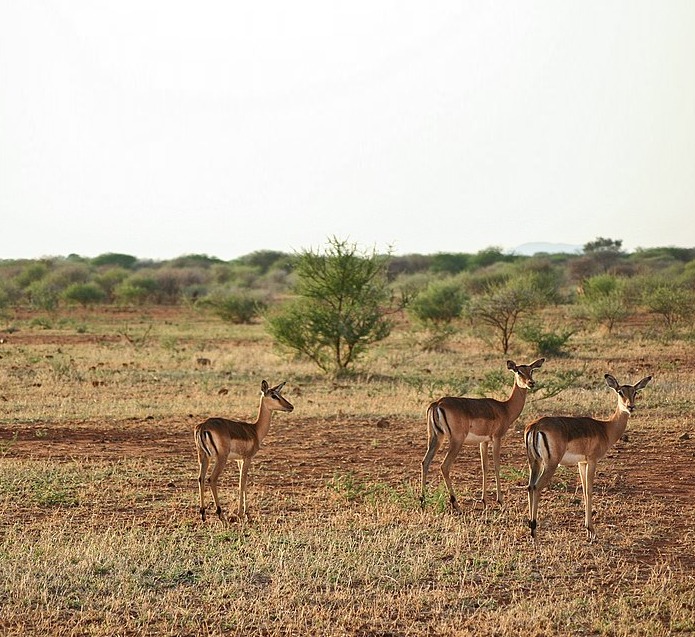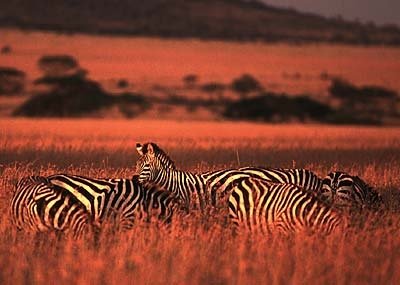Madikwe Game Reserve, created in 1991, sits right on the South Africa-Botswana border in a malaria-free area. The park was named after the Marico or Madikwe River and is one of the largest reserves in South Africa. It is home of 66 large mammal species and several other wildlife species, including 300 migrant and resident bird species and the Big 5.
The reserve is located in North West Province and borders Botswana, about the drive of 3.5 hours from both Pretoria and Johannesburg. Madikwe Game Reserve is the only place in South Africa where Kalahari Gemsbok and Springbok naturally meet.
The reserve lies inside a transition zone between the Kalahari thornveld and Lowveldbushveld. As a result, it is host to an impressive variety of species from both ecosystems. Topographically, the land has extensive volcanic disruptions known as Inselbergs, wide-open fields, and fluvial environment along the Marico River, within the east of the reserve.
The bushveld, a transition zone on the edges of the Kalahari, and unique location are the remarkable characteristics of this place. The climate of Madikwe is mild to hot, but in winter, nights can be cold. The reserve comprises of broad plains of open grasslands and woodlands. They are bordered by the Dwarsberg Mountains in the south and dissected by the bumpy Rant van Tweedepoort.
In the largest movement of animals since Noah filled his arc, the 30,352 acres (75,000 ha) reserve was stocked with 10,000 head of game from 27 different species. The park’s very existence contributes to the preservation of local fauna and flora and rare animals such as rhino and wild dog, and also provides a more sustainable environment for the local people.
The whole reserve has been encased in a 150 kilometers perimeter fence, which has been electrified to avoid being chased by bigger predators and elephants. It is relatively near the Pilanesberg National Park, and presently, there is a two years plot between the two secured regions that will ultimately lead to the formation of a corridor between the two parks.
Natural History
Madikwe reserve lies on the land (90 kilometers north of Zeerust), which was used for farming. But due to barren soil type, cultivation could not become successful. After considerable research, the government of South Africa found the land to be ideally utilized as a park to lift its economy.
Not only does this reserve boast the ‘Big Five’ but it also has the ‘Super 7’!
This adds cheetah and wild dog to the traditional five; leopard, lion, buffalo, elephant and rhino. Plus brown hyena, sable, eland, gemsbok, giraffe and large herds of plains game and plenty of birds. This brought up the total population of the mammals of the reserve up to over 10,000.
Wild dogs are a specialty of the area, and due to their rarity and fascinating behavior, they are a wonderful sight. They are also known as Cape hunting dogs or painted dogs because of their tricolored (black, white and tan) abstract coat. Wild Dogs are Africa’s most formidable hunters (followed by hyena and lion), and the essence of their successful social system is co-operative hunting and food sharing.
Not only do they regurgitate food for the young, but the babysitter gets fed too. They travel great distances while hunting and, as a result, often traverse farmland where they were almost shot to extinction. Luckily, they are thriving in Madikwe.
Outside the head reserve, the private farm has recently been opened. The privileged customers have to obey the broad rules of the park, and animals can meander over any region, but there are limitations as to where private transport is allowed.
Outside the head reserve, there are six lodges in private farms and thirty on the property. The community cottages are owned and run by the locals, and the profit is used to boost the communities.
The part now by itself is 680 square kilometers, and including the incorporated privately owned land, it is 750 square kilometers. The landscape is chiefly bushveld plain, distributed with rocky outcrop and exclusive mountains, and open grassland.
Madikwe is considered as one of the preferable conservative areas in Africa, presenting all the vital species, including elephants, black rhinos, leopards, Cape buffaloes, white rhinos, and lions along with all the moor antelope species.
Things to Know About the Park
- Zeerust is the nearest town to Madikwe in Africa, a few ninety kilometers away from the reserve.
- Madikwe is located in the well-known Sun City Entertainment and Casino Complex. It shares a border with the Pilanesberg Game Reserve.
- By air, Madikwe is 75 kilometers from the Pilanesberg Game Reserve, and it takes the drive of about 2 hours by car.
- The considerable difference between Pilanesberg Game Reserve and Madikwe, apart from the size, is that day tourists are not allowed in Madikwe.
- Tau Gate, Abjaterskop Gate, Motledi Gate, Wonderboom Gate, and Derdepoort Gate are the five entrance gates into Madikwe. Wonderboom Gate is the main access door.
- The dramatic Dwarsberg Mountain and Rant Van Tweedepoort are the two influencing natural landmarks of vast savanna plains of Madikwe.
- Rare species of extremely endangered and intimidating black and white rhinos along with a flourishing population of wild dogs, leopards, and cheetah can be found in Madikwe.
- Madikwe Game Reserve has an ample collection of 60 lions. It is conventional for its growing pack of wild dogs. Together with mighty populations of cheetah, Madikwe, instead of Big 5, boasts Big 7 as a traveler drawcard.
Best Time to Visit Madikwe
Madikwe is an ideal safari destination all around the year. It is due to the reason that there is no crucial migration of wildlife since Madikwe is a single unit conservation region – means that animals remain in reserve permanently.
Wet summer months (October to March) are the ideal time for birding enthusiasts to visit. This is the time when the migrants expand the numbers of species. Due to the presence of several captivating resident birds’ species, dry months are still a pleasant time for birders.
For game viewing, the winter months (approximately July through September) can be pleasurable and enjoyable with cold nights and warm days.
Transportation Options
From the landing field in both the north and south of Madikwe, Federal Air manages air services to O.R. Tambo International Airport. The flight takes almost 55 minutes, and the drive from Johannesburg is about 5 hours.
Seasons
- Rainy Season
It rains from October to April, with the highest rainfall expected between November and February. Daytime temperatures are hot and humid, with an average of 88°F (31°C). The rainy season is overlapped with summers. In the late afternoon, cooling thunderstorms are usual, and evenings are mild, with a temperature of 64 °F (18 °C).
- Dry Season
The winter months of May to September are dry and cold with evening temperatures as low as 35.5°F (2°C) and only 72°F (22°C) in the daytime.
Home | African Mammals List | African Birds List | African Trees List | Wildlife Safari Habitats
Lodges


